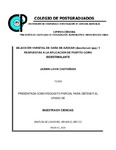| dc.contributor.author | Lavin Castañeda, Jazmin | |
| dc.creator | LAVIN CASTAÑEDA, JAZMIN;932230 | |
| dc.date.accessioned | 2021-03-16T19:04:43Z | |
| dc.date.available | 2021-03-16T19:04:43Z | |
| dc.date.issued | 2020-07 | |
| dc.identifier.uri | http://hdl.handle.net/10521/4438 | |
| dc.description | Tesis (Maestría en Ciencias, especialista en Innovación Agroalimentaria Sustentable).- Colegio de Postgraduados, Campus Córdoba, 2020. | es_MX |
| dc.description.abstract | La caña de azúcar es un cultivo de gran importancia a nivel global, pues de ella deriva el 80% de la azúcar de mesa que se consume en el mundo, y además es fuente de fibra, biomasa y bioenergía. México es el sexto productor mundial de azúcar, cuya la producción se sustenta en tan solo cuatro variedades que ocupan el 70% de superficie sembrada, lo que hace vulnerable al sistema ante embates ambientales de naturaleza tanto biótica como abiótica, agravados por cambio climático. Por lo tanto se requiere generar nuevos materiales genéticos así como la implementación de alternativas que hagan más eficiente el sistema de producción de una perspectiva más sustentable, incluyendo el uso de productos bioestimulantes como el fosfito (Phi) que pueden aumentar los mecanismos de tolerancia a factores de estrés, y que a su vez pueden incrementar la calidad de los productos. En esta tesis de maestría en ciencias se analizaron 36 variedades de caña de azúcar en Fase Prueba de Adaptabilidad derivados del programa de selección que implementó en 2009 el Colegio de Postgraduados Campus Córdoba, siguiendo las metodologías descritas por el Instituto para el Mejoramiento de la Producción de Azúcar (IMPA) y la Unión Internacional para la Protección de Nuevas Variedades de Plantas (UPOV). En paralelo se establecieron dos experimentos independientes donde se implementaron herramientas para determinar el efecto de la aplicación foliar de Phi (80 mM) en dos variedades comerciales CP 72-2086 y Mex 69-290 probando aplicaciones foliares. Dentro del proceso de selección varietal sobresalieron 27 variedades que están siendo evaluadas en Fase de Evaluación Agroindustrial, algunas de ellas con rendimientos potencialmente superiores a los testigos regionales. Además, se encontró que el Phi no tuvo efectos significativos en las variables fisiológicas y nutrimentales, pero sí aumentó la concentración de sólidos solubles totales en el jugo de tallos molederos, lo cual es un atributo importante para la industria azucarera. _______________ VARIETAL SELECTION OF SUGARCANE (Saccharum spp.) AND RESPONSES TO THE APPLICATION OF PHOSPHITE AS A BIOSTIMULANT. ABSTRACT: Sugarcane is a crop of great importance globally, since 80% of the table sugar consumed in the world is derived from it, and it is a source of fiber, biomass and bioenergy. Mexico is the sixth world sugar producer, whose production is supported by only four varieties that occupy 70% of the planted area, which makes the system vulnerable to environmental stressors of both biotic and abiotic nature, aggravated by climate change. Therefore, it is required to generate new genetic materials as well as the implementation of alternatives that make the production system more efficient from a more sustainable perspective, including the use of biostimulant products such as phosphite (Phi) that can increase tolerance mechanisms to stress factors, which in turn can increase the quality of the products. In this master's in science thesis, 36 varieties of sugarcane were analyzed in the Adaptability Test Phase derived from the selection program implemented in 2009 by the College of Postgraduates in Agricultural Science Campus Córdoba, following the methodologies described by the Institute for the Improvement of the Production of Sugar (IMPA) and the International Union for the Protection of New Plant Varieties (UPOV). In parallel, two independent experiments were established to determine the effect of foliar application of Phi (80 mM) in two commercial varieties CP 72-2086 and Mex 69-290. Within the varietal selection process, 27 varieties stood out that are being evaluated in the Agroindustrial Evaluation Phase, some of them with yields potentially higher than the regional controls. Furthermore, it was found that the Phi did not have significant effects on the physiological and nutritional variables, but it did increase the concentration of total soluble solids in the juice of mature stalks, which is an important attribute for the sugar industry. | es_MX |
| dc.description.sponsorship | Consejo Nacional de Ciencia y Tecnología (CONACyT). | es_MX |
| dc.format | pdf | es_MX |
| dc.language.iso | spa | es_MX |
| dc.rights.uri | http://creativecommons.org/licenses/by-nc-nd/4.0 | es_MX |
| dc.subject | Poaceae | es_MX |
| dc.subject | Mejoramiento genético | es_MX |
| dc.subject | Bioestimulación | es_MX |
| dc.subject | Hormesis | es_MX |
| dc.subject | Plant breeding | es_MX |
| dc.subject | Biostimulation | es_MX |
| dc.subject | Maestría | es_MX |
| dc.subject.classification | CIENCIAS AGROPECUARIAS Y BIOTECNOLOGÍA::CIENCIAS AGRARIAS::AGRONOMÍA::NUTRICIÓN VEGETAL | es_MX |
| dc.title | Selección varietal de caña de azúcar (Saccharum spp.) y respuestas a la aplicación de fosfito como bioestimulante. | es_MX |
| dc.type | Tesis | es_MX |
| Tesis.contributor.advisor | Gómez Merino, Fernando Carlos | |
| Tesis.contributor.advisor | Trejo-Téllez, Libia Iris | |
| Tesis.contributor.advisor | Bello Bello, Jericó Jabín | |
| Tesis.date.submitted | 2020-07 | |
| Tesis.date.accesioned | 2021 | |
| Tesis.date.available | 2021 | |
| Tesis.format.mimetype | pdf | es_MX |
| Tesis.format.extent | 10,577 KB | es_MX |
| Tesis.subject.nal | Saccharum | es_MX |
| Tesis.subject.nal | Ensayos de variedades | es_MX |
| Tesis.subject.nal | Variety trials | es_MX |
| Tesis.subject.nal | Morfología de las plantas | es_MX |
| Tesis.subject.nal | Plant morphology | es_MX |
| Tesis.subject.nal | Valor nutritivo | es_MX |
| Tesis.subject.nal | Nutritive value | es_MX |
| Tesis.rights | Acceso abierto | es_MX |
| Articulos.subject.classification | Caña de azúcar | es_MX |
| dc.type.conacyt | masterThesis | es_MX |
| dc.identificator | 6||31||3103||241717 | es_MX |
| dc.contributor.director | GÓMEZ MERINO, FERNANDO CARLOS; 123311 | |
| dc.audience | other | es_MX |


